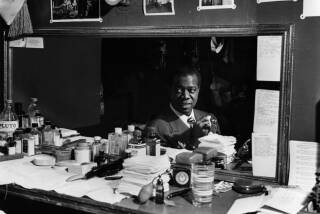Rabbath Challenges the Basics of the Bass
- Share via
Francois Rabbath seems much too genial for fanaticism, too relaxed and down-to-earth for serious obsession. At 57 a short, voluble person of open charm, Rabbath is nonetheless a musical missionary who feels a very real calling.
“She spoke to me and chose me,” Rabbath says earnestly, talking about the double bass. “I didn’t choose her.”
The man who has challenged the fundamentals of traditional bass techniques was 13 when he saw his first double bass. Born in Syria, he moved with his family--six brothers and four sisters--to Beirut after World War II. The failure of their father’s banking business forced the brothers to make music pay, in nightclubs and hotels. Needing a bassist, Rabbath’s oldest brother brought a bass home one evening.
“ ‘I’ve never seen a violin so big, who can this be for?’ I asked my brother,” Rabbath recalls. He fell immediately under the spell of the big, reverberant sound. Lest anyone separate him from it, he took the unwieldy instrument to bed with him that first night.
The journey from Lebanon to Paris and an uneasy preeminence as a celebrated provocateur of the bass was a long one. He taught himself to read music from a bass method by Edouard Nanny, which nine years later led Rabbath to France, where he was disappointed to find that Nanny had died 20 years before. He was accepted into the Paris conservatory, only to leave three days later in a dispute with his professors over fingering.
“I have always been an autodidact,” Rabbath states proudly.
That, he agrees, has made it easier to develop his own technical methods, which he is eager to share with all bassists. He has completed a three-volume method of his own and is in great demand for clinics and master classes, such as the three he taught at the International Society of Bassists convention at UCLA this week.
The heart of his new technique is a reduction in shifting, slashing the positions on the bass from 14 to just five. He has, he avows, 130 different fingerings for each scale.
“Throw it away and grow up,” Rabbath exclaims about the old method. This has not endeared him to bass teachers everywhere, many of whom, he says, are afraid to let go their hard-earned skills and start over.
Paul Ellison can sympathize with the fears of other professionals. Now professor of bass at USC, he had been principal bass of the Houston Symphony for 12 years when he decided to move to Paris for six months and learn the new technique directly from Rabbath.
After a few weeks, Ellison says “I was ready to throw the bass against the wall.” He persevered, however, insisting that Rabbath teach him not only the technique itself, but the process through which he had discovered it.
Now, Ellison says, more schools in the U.S. than in France teach Rabbath’s technique. Both he and Rabbath, however, say that the Paris conservatory does use Rabbath’s method.
“They still don’t admit it,” Rabbath says, “but they do use it.” He reports hearing his etudes in classrooms, only to find all copies of his method hidden away when he enters the room.
Ellison doesn’t worry about resistance to the new technique, believing that the superiority of players trained that way will make it a dead issue for the next generation. Rabbath, though, mourns for the unconverted. “The students are the victims of the old way,” he says. “Later, they will come to it (his technique), but they will have lost so much time.”
The new technique will be on display this evening, when Rabbath gives a recital in Schoenberg Hall, accompanied by pianist Liliana Hsueh. He will play some pieces by Bach and Vivaldi, but the bulk of the program, which he will announce from the stage, will be of his own compositions.
“I prefer to play my own music because it shows better the richness of the bass,” Rabbath says. “Every sonority I exploit, not just to have a gimmick. It’s become something very noble.”
More to Read
The biggest entertainment stories
Get our big stories about Hollywood, film, television, music, arts, culture and more right in your inbox as soon as they publish.
You may occasionally receive promotional content from the Los Angeles Times.










